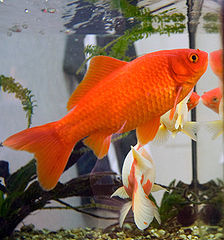
Please welcome back Frank Indiviglio for another article.
Today I’d like to introduce you to the maintenance of cold water aquariums, a fascinating but often overlooked branch of aquarium keeping focusing on marine and freshwater fishes and invertebrates from temperate regions.
Exotics Close to Home
Please don’t be misled into equating exotic and interesting creatures with “far-off, tropical places”. Shorelines, ponds, tidal pools and rivers throughout the world’s temperate regions (with the exception of extreme s. Florida, the entire USA is in the temperate zone) yield animals of unimaginable variety and interest. While it is true that many of the most spectacularly colored fishes are found in the warmer parts of the world (their bright colors likely help males and females of the same species recognize each other among the great diversity of similar species in the tropics), breeding males of many temperate fish species, i.e. the sunfishes, do rival those of their tropical counterparts.
Why keep Temperate Fishes and Invertebrates?
Animals from temperate areas offer many advantages to aquarists who live in the USA. Often, our normal seasonal rhythms of temperature and light fluctuation are sufficient to encourage such creatures to exhibit natural behaviors, and even to breed. Also, it is often easier for us to provide a wider range of foods and a more natural environment for them than we can for creatures from faraway places. In some cases, where legal, we may even be able to collect and keep native fishes and invertebrates.
Creating Natural Habitats
If you live near a body of water, try to observe firsthand the environments and habits of a variety of aquatic creatures. You might consider modeling your aquarium after a particular habitat — a tide pool, a weedy, fresh-water pond, or a river bed, for example. Take note of the local substrates, rocks and other natural items and purchase similar ones when setting up your tank prod (collecting natural substrates is risky, due to the possibility of mineral, pesticide or other chemical leaching).
Heat
Cold water aquariums are maintained in a similar fashion to tropical aquariums, but we must consider the effects of heat. Many animals from temperate regions are very sensitive to rising water temperatures and to the lower oxygen levels that accompany them. You may, therefore, need to install a chiller to moderate temperatures during the summertime.
Species to Consider
Some of the animals that I have maintained with success in cold water aquariums, and which I plan to cover in future additions to this article, include American eels, fifteen-spined sticklebacks, pygmy and other sunfishes, mantis shrimp, sea stars, Chinese sailfin suckers, weather fish, horseshoe crabs, blue claw crabs, bullheads and madtoms, white clouds, various snails, crayfish and shrimp, giant water bugs and other aquatic insects and many others.
I’ll now give a quick overview of two unusual animals – the oyster toadfish and the spider crab – which are easily maintained in unheated marine aquariums. I’ll cover their husbandry in detail in future articles.
Oyster Toadfish, Opansus tau
This unusual marine fish, ranging down the Eastern Seaboard from Maine to Cuba, seems to cross the line between fish and amphibian – its face even resembles that of a toad. In addition, toadfishes produce sounds audible above the water and certain Asian species can travel overland for considerable distances.
Oyster toadfishes will become quite tame in captivity, and, given a tank of 55 gallons or so, may well breed. Males are ferocious guardians of their eggs, and have been known to stay with nests that are exposed at low tide.
Oyster toadfishes have survived for 15 years in captivity, and will accept nearly any meat-based frozen or pelleted food as well as live shrimp, small fishes and worms. They learn to associate their owners with food, but will bite when handled, and the spines that can inflict painful wounds.
Atlantic Spider Crab, Libinia emarginata
Spider crabs, common yet fascinating if you take the time to know them, are members of a family which includes the Japanese spider crab. With legs spanning 8 feet, these giants awed me when first I observed a large group in a pubic aquarium in Osaka, Japan. American aquariums now exhibit them as well – trust me, they are well worth the trip.
The Atlantic spider crab is a valuable aquarium scavenger, and, using its tiny pointed claws to probe into nooks and crannies, misses little. Younger animals have the endearing habit of jamming algae and vegetation into the crevices of their shells, taking on the appearance of a “walking plant”. They will also nibble at this portable garden from time to time. I have found that they forgo this habit when they reach a carapace size of about 3 inches, although I have yet to discover why.
Spider crabs rarely bother tank-mates and readily consume fish flakes, pellets, blackworms, frozen food fish foods, algae and green leafy vegetables.
In the next installment of this article I’ll write about temperate, fresh water animals that are readily available in the pet trade. Until then, please write in with your questions and comments. Thanks. Until next time, Frank.
Information on the natural history of the oyster toadfish, along with a photo, is available at:
http://fishbase.mnhn.fr/Summary/SpeciesSummary.php?id=3069&lang=Portuguese
Thanks Frank
Until Next Time,
Dave
 That Fish Blog – Aquarium Advice and Information
That Fish Blog – Aquarium Advice and Information








